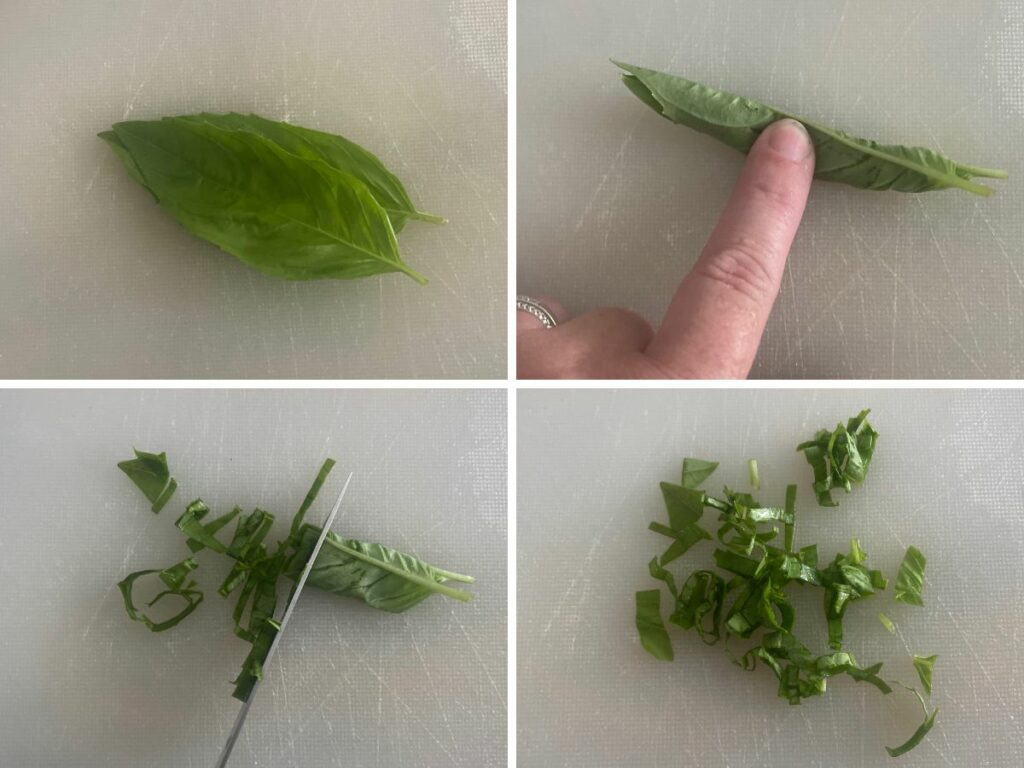As an Amazon Associate I earn from qualifying purchases. This website also participates in other affiliate programs and may earn commissions if you shop through the links used on this website.
(This article was originally published on August 3, 2022 and was last updated on August 3, 2022)
When I think about things that pair well with basil, I have to admit it’s hard to get my brain to think very far beyond pizza. Fresh mozzarella cheese, a simple sauce made with fresh tomatoes, and gorgeous green basil leaves…it’s hard to beat!
And while it’s not controversial to declare basil is a delicious pizza topping, it is surprisingly controversial when it comes to timing, and exactly when in the cooking process to put fresh basil on pizza.
If you’ve been wondering when to add fresh basil to pizza, you’ve come to the right place. Keep reading for the 5 options for adding fresh basil as a pizza topping, and when you should choose one or another.
Onward, pizzaiolo!
When to put Basil on Pizza
There’s no hard or fast rule about when to put fresh basil on pizza, and you’re likely to find different approaches to this question in different places.
While some sources suggest whether you add fresh basil to pizza before or after cooking depends on the type of pizza oven you use (wood fired/brick oven vs electric oven), and the basil placement on the pizza (on top of the cheese or underneath the cheese), the fact is you can find all sorts of examples of legendary pizza places placing their basil on pizza at different times in the pizza making process.
In Naples, the home of pizza, you’re likely to find restaurants add fresh basil to the pizza before cooking it in a wood fired oven. Jamie Oliver agrees, it would seem!
On the other hand, Brooklyn’s legendary Lucali adds fresh basil after cooking, and cooks their pizzas in a brick oven.
So what’s the right answer for your next pizza?

The Problem with Fresh Basil in a Pizza Oven
Basil is a fairly delicate herb, and doesn’t do well at high heat, or being heated for long stretches in an oven. When exposed to heat, basil leaves can oxidize, which causes them to turn from beautiful green or purple to brown or grey, shrivel up, and get a bit blackened and crunchy.
Traditional pizza Napoletana is made in a wood fired or brick oven, cooked at extremely high heat (around 500 degrees F) for an extraordinarily short time (around a minute or two). Adding fresh basil on top of the pizza dough, and then baking it using this method, there’s not a lot of time for the basil to turn black, wither away, or get crunchy on the edges.
However, most of us don’t have brick ovens for our pizzas at home. And herein lies the problem with adding fresh basil to pizza: when we cook it at home, the basil is quick to blacken, wither, and get burnt or crunchy.
When to Put Fresh Basil on Pizza? 5 Options & How to Choose
Here are the four main suggestions or approaches in terms of when to add basil to your pizza:
- Adding fresh whole basil leaves before cooking the pizza
- Throw basil leaves (whole, rough or finely chopped, or thinly sliced as a chiffonade) on your pizza after cooking
- Add fresh basil leaves in the middle of cooking the pizza
- Top your pizza with fresh basil leaves after its cooked and has rested for a few minutes
- Put fresh basil on pizza before cooking and before adding mozzarella – this is the mozzarella on top method.
Which of these options you choose depends on how you plan to cook your pizza, as well as your personal preference and what you consider to be a great pizza!
Cooking with an Ooni, or Similar at Home Pizza Oven
If you’re using one of the purpose-built at home pizza ovens, such as the Ooni, you’re good to add fresh basil to your pizza before baking, after its finished baking, or in the middle of baking.
The Ooni gets really, really hot – like up to 900 degrees F hot – which means your pizza can be in and out in about two minutes.
Santa Barbara Baker throws basil on his pizza before baking in his Ooni, and you can see that while the basil does darken and shrink a bit, it still looks amazing, when using fresh whole basil leaves on top of the mozzarella.
If you tear, chop or chiffonade your basil before cooking the pizza, it doesn’t stand up to the heat of the Ooni as well. Therefore, if you’re going to put your basil on your pizza before cooking in the Ooni, I recommend using fresh whole leaves, rather than chopped leaves.
There’s a third option that I like, which is cooking the pizza first for about 1 minute / 1 minute 20 seconds, and pulling it out of the Ooni. At this point, when the pizza is almost cooked, toss the fresh basil leaves on and return it to the oven for another 40 to 60 seconds.
Cooking Pizza in a Standard Electric Oven at Home
Cooking a great pizza at home, in your normal kitchen oven, is a bit different from using an ultra high heat pizza oven.
Pizza is best when cooked at high heat, so you’ll want to preheat your oven before beginning to the highest heat setting, and give it a bit of extra time (20 to 30 minutes) at high heat before you put the pizza in the oven. If you have one, use a preheated pizza stone or pizza steel (or flip over a baking sheet to serve as a makeshift pizza steel).
Even if you crank the heat on the oven, you’ll still need to bake your pizza for 8 to 12 minutes in a conventional electric oven.
This presents a problem for basil, as that long at that heat will transform the texture, flavors, look and aroma of the basil – and not for the better.
When cooking pizza at home in your conventional oven, the best time to add fresh basil to your pizza is:
- At the end, when you’ve pulled the pizza fresh out of the oven. Top with ribbons, rough chopped basil, or whole leaves.
- In the middle of the baking process. Bake the pizza for about 5 to 8 minutes, pull it out and add the mozzarella and fresh basil on top, and then put it back in the oven for another 3 to 5 minutes.
- After the pizza has rested for 2 to 3 minutes. This is an okay option if you’re using chiffonade or finely chopped basil, which is more likely to wilt and blacken if you add it on top of scalding hot cheese straight from the oven. By giving the cheese a few minutes to rest and cool, the basil will remain fresh and green.
The Mozzarella on Top Method
Some food bloggers and vloggers recommend putting fresh basil under the pizza mozzarella. The fat and moisture from the cheese does give the basil a bit of protection from the heat, so this is another viable option.
I will say, it’s not my favorite option, as I think it takes away from the aesthetic of the pizza (fresh basil leaves look beautiful on pizza, IMO) and I don’t like getting surprise bites of cooked basil, because it can occasionally get stringy, and I want to be prepared for those bites.
What Happens if you Put Fresh Basil on Pizza Before Baking?
Cooking basil changes its texture, flavor and aroma, so whether you decide to add fresh basil to your pizza before or after baking depends on your own preferences, as well as the type of basil you’re cooking with.
Normal basil (sweet basil or Genovese basil) is probably the most common basil to use on a pizza, and the guidelines above apply well to cooking with sweet basil.
However, if you’re using a basil with a stronger and more pungent flavor, you’ll likely notice it loses flavor when cooked for too long, and mellows out when cooked just a bit.
Likewise, the color of basil leaves you’re using matters whether you add the fresh basil before cooking your pizza, or after. Green basil will change color somewhat, getting darker. But purple basil can look really ugly when cooked – turning black or grey, which isn’t too appealing on a beautiful delicious pizza! If you’re using a purple basil, add it after cooking to avoid this unappetizing color change.
How to Put Basil on Pizza?
How you put fresh basil on pizza depends on when you put it on the pizza. You can use fresh leaves, finely chopped chiffonade ribbons, fine/rough chopped basil leaves, or torn up leaves.

Fresh Whole Leaves
This is probably the most classic way to top pizza with fresh basil leaves – simply remove leaves from the stems, give them a wash and pat them to dry, and then space them out over the top of the pizza.
Basil Chiffonade on Pizza
If you find whole leaves too much on your pizza, try using a chiffonade cutting technique. The result is beautiful thin ribbons of fresh basil, and the chiffonade technique helps prevent bruising on the leaves, resulting in gorgeous coloring.
To chiffonade your basil leaves, wash and pat the leaves to dry. Remove the leaves from the stem, and stack the leaves on top of one another on a cutting board, placing the largest leaves at the bottom of the stack and the smallest leaves at the top.
Then, roll your stack of basil leaves as if you’re rolling a cigarette or cigar. Keeping the “cigar” tight, use a sharp knife to cut the basil cross-wise in really thin slices. Only cut once to reduce bruising, and cut the ribbons as thin as you can.
When you’re done, the basil will unravel to reveal beautiful thin and fragrant ribbons that are perfect for tossing on fresh from the oven pizza.
In my experience, basil chiffonade is too delicate to cook in a pizza oven for long, so this technique is best for adding to already cooked pizza, or add towards the end of the cooking process, heating up for a minute or two to finish.

Torn Up or Chopped
In addition to using whole leaves or a chiffonade, you can simply rough chop your basil (which may result in some bruising) or tear the leaves with your fingers whole holding them over the pizza.
What About Dried Basil on Pizza? Save it for the Tomato Sauce or Homemade Pizza Dough
While Neapolitan style pizza doesn’t use basil in the marinara sauce, if you feel like getting creative, you can add dried basil to your homemade pizza sauce, or make an herbed pizza dough.
